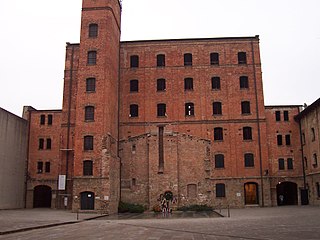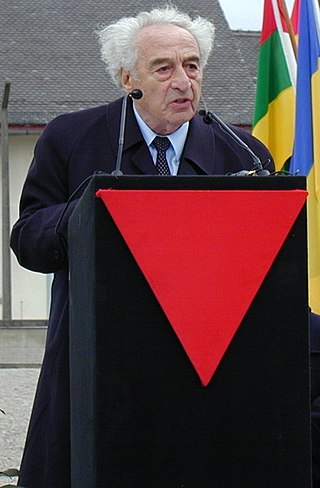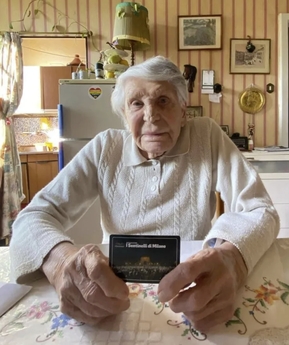
Buchenwald was a Nazi concentration camp established on Ettersberg hill near Weimar, Germany, in July 1937. It was one of the first and the largest of the concentration camps within the Altreich. Many actual or suspected communists were among the first internees.
Karl-Otto Koch was a mid-ranking commander in the Schutzstaffel (SS) of Nazi Germany who was the first commandant of the Nazi concentration camps at Buchenwald and Sachsenhausen. From September 1941 until August 1942, he served as the first commandant of the Majdanek concentration camp in occupied Poland, stealing vast amounts of valuables and money from murdered Jews. His wife, Ilse Koch, also participated in the crimes at Buchenwald.

Mittelbau-Dora was a Nazi concentration camp located near Nordhausen in Thuringia, Germany. It was established in late summer 1943 as a subcamp of Buchenwald concentration camp, supplying slave labour from many Eastern countries occupied by Germany, for extending the nearby tunnels in the Kohnstein and for manufacturing the V-2 rocket and the V-1 flying bomb. In the summer of 1944, Mittelbau became an independent concentration camp with numerous subcamps of its own. In 1945, most of the surviving inmates were sent on death marches or crammed in trains of box-cars by the SS. On 11 April 1945, US troops freed the remaining prisoners.

Richard Baer was a German SS officer who, among other assignments, was the final commandant of Auschwitz I concentration camp from May 1944 to January 1945, and right after, from February to April 1945, commandant of Mittelbau-Dora concentration camp. Following the war, Baer lived under an assumed name to avoid prosecution but was recognized and arrested in December 1960. He died in detention before he could stand trial.

Sachsenhausen or Sachsenhausen-Oranienburg was a German Nazi concentration camp in Oranienburg, Germany, used from 1936 until April 1945, shortly before the defeat of Nazi Germany in May later that year. It mainly held political prisoners throughout World War II. Prominent prisoners included Joseph Stalin's oldest son, Yakov Dzhugashvili; assassin Herschel Grynszpan; Paul Reynaud, the penultimate prime minister of the French Third Republic; Francisco Largo Caballero, prime minister of the Second Spanish Republic during the Spanish Civil War; the wife and children of the crown prince of Bavaria; Ukrainian nationalist leader Stepan Bandera; and several enemy soldiers and political dissidents.

LTI – Lingua Tertii Imperii: Notizbuch eines Philologen (1947) is a book by Victor Klemperer, Professor of Literature at the Dresden University of Technology. The title, half in Latin and half in German, translates to "The Language of the Third Reich: A Philologist's Notebook"; the book is published in English translation as The Language of the Third Reich.

The Langenstein-Zwieberge was a concentration camp, an under-camp of the Buchenwald concentration camp. More than 7000 prisoners from 23 countries were imprisoned there between April 1944 and April 1945. The camp was situated in the village of Langenstein, Saxony-Anhalt, which has since been absorbed into the town of Halberstadt.
Riederloh was the name of two camps providing forced laborers to the gunpowder and ammunition facility of Dynamit AG (DAG) in Kaufbeuren, Bavaria. Located approximately 80 km to the southwest of Munich in Nazi Germany, the camps were named "Riederloh" and "Riederloh II" respectively.

Risiera di San Sabba is a five-storey brick-built compound located in Trieste, northern Italy, that functioned during World War II as a Nazi concentration camp for the detention and killing of political prisoners, and a transit camp for Jews, most of whom were then deported to Auschwitz.

Bolzano was a transit camp operated by Nazi Germany in Bolzano from 1944 to 3 May 1945 during World War II. It was one of the largest Nazi Lager on Italian soil, along with those of Fossoli, Borgo San Dalmazzo and Trieste.
In Nazi concentration and labor camps the system of Funktionshäftlinge, or prisoner functionaries was developed. These were the prisoners with certain duties of supervision of over fellow prisoners assisting the camp administration and guards (SS-Totenkopfverbände), in exchange for various privileges. These should be distinguished from various work units known as Sonderkommando (not to be confused with theSS-Sonderkommandos. Of these, best known are Kapos.

The Esterwegen concentration camp near Esterwegen was an early Nazi concentration camp within a series of camps first established in the Emsland district of Germany. It was established in the summer of 1933 as a concentration camp for 2000 so-called political Schutzhäftlinge and was for a time the second largest concentration camp after Dachau. The camp was closed in summer of 1936. Thereafter, until 1945 it was used as a prison camp. Political prisoners and so-called Nacht und Nebel prisoners were also held there. After the war ended, Esterwegen served as a British internment camp, as a prison, and, until 2000, as a depot for the German Army.

International concentration camp committees are organizations composed of former inmates of the various Nazi concentration camps, formed at various times, primarily after the Second World War. Although most survivors have since died and those who are still alive are generally octogenarians, the committees are still active.

Subcamps, officially Arbeitslager der Waffen-SS, were outlying detention centres (Haftstätten) that came under the command of a main concentration camp run by the SS in Nazi Germany and German-occupied Europe. The Nazis distinguished between the main camps and the subcamps subordinated to them. Survival conditions in the subcamps were, in many cases, poorer for the prisoners than those in the main camps.

Vinzenz Schöttl was a German Schutzstaffel (SS) officer and high-ranking functionary in the Nazi concentration camps.
Aktion Gitter was a "mass arrest action" by the Gestapo which took place in Nazi Germany between 22 and 23 August 1944. It came just over a month after the failed attempt to assassinate the country's leader, Adolf Hitler, on 20 July 1944. The programme targeted former officials and members of mainstream centre and left-wing "Bourgeois" parties from the period of democratic government that were declared illegal after January 1933. Those arrested included Social Democrats and trades unionists, Liberals, Communists and Bavarian People's Party members, along with members of the old centre parties.

Der Ort des Terrors. Geschichte der nationalsozialistischen Konzentrationslager is a nine-volume German encyclopedia series of Nazi Germany's camp system, published between 2005 and 2009 by Wolfgang Benz and Barbara Distel for C. H. Beck. It was edited by Angelika Königseder of the Zentrum für Antisemitismusforschung. The first volume deals with central issues concerning the Nazi camp system, volumes 2 to 7 contain articles on the main concentration camps and their subcamps in chronological order. Volume 8 deals with concentration and extermination camps in German-occupied Eastern Europe. Volume 9 also lists other types of camps in the Nazi forced labor camp system.

Dachau is a 72-page investigation report by the 7th US Army on Dachau, one of the concentration camps established by Nazi Germany. The report details the mass murder and mass atrocities committed at Dachau by the SS and other personnel. Following the liberation of the camp by the 7th US Army on 29 April 1945, the report was prepared during the following one or two weeks and published in May. In addition to a preface, the report contains three independent reports which partly overlap thematically. Although it contains some errors, the report is considered one of the first studies on the Nazi concentration camps.

Lucy Salani was an Italian activist and the only known Italian transgender person to have survived the Nazi concentration camps. Born in Fossano and raised in Bologna, Salani was understood to be a gay man before undergoing gender-affirming surgery later in her life. An anti-fascist, Salani deserted both the fascist Italian and the Nazi German armies during World War II before being caught and deported to Dachau concentration camp in 1944, where she remained until the liberation of the camp by the United States Armed Forces in April 1945.














